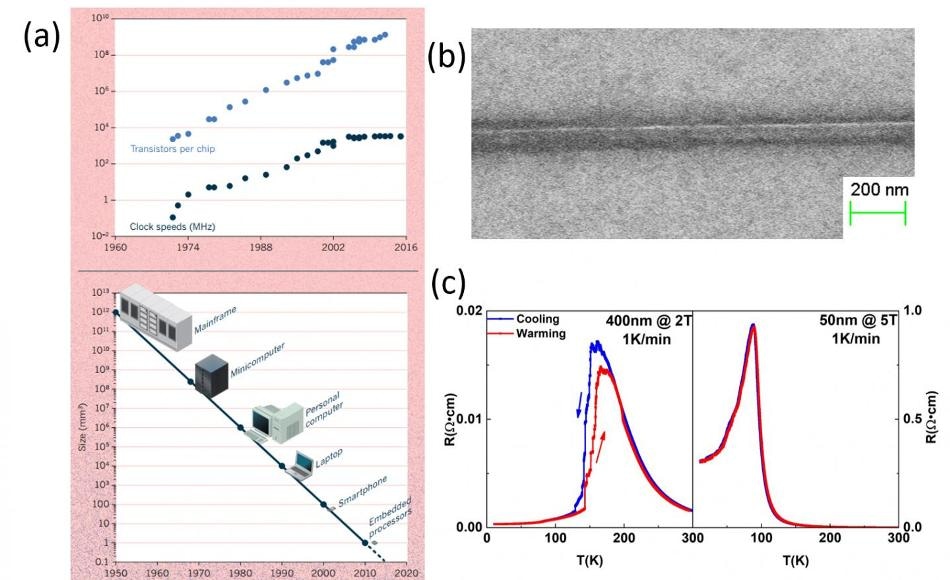Nov 25 2019
The semiconductor sector has grown for over 40 years by using Moore’s law. As the size of transistors reduces to one-tenth of the nanometer scale, the quantum effects begin to dominate and lead to issues such as heat generation and operation stability.
 (a) Moore’s law: the number of transistors per microprocessor chip has roughly doubled every two years [1]. (b) A 100 nm manganite nanowire fabricated. (c) The transport properties of the nanowires showing significantly enhanced quenched disorder effects in 50 nm nanowire. Image Credit: Science China Press.
(a) Moore’s law: the number of transistors per microprocessor chip has roughly doubled every two years [1]. (b) A 100 nm manganite nanowire fabricated. (c) The transport properties of the nanowires showing significantly enhanced quenched disorder effects in 50 nm nanowire. Image Credit: Science China Press.
Another way is to create advanced functional materials and advance their architecture. Complex oxide is one of the most useful materials. Researchers have recently demonstrated new features of complex oxide at the nanoscale, as well as its potential for use in various applications.
In the study titled “Spatial confinement tuning of quenched disorder effects and enhanced magnetoresistance in manganite nanowires,” which was published in SCIENCE CHINA Physics, Mechanics & Astronomy (first author—Yang Yu; corresponding authors—Hangwen Guo, Lifeng Yin, and Jian Shen), researchers used most sophisticated nanolithography methods to design a series of complex oxide called manganite nanowires in the range of 5 μm to 50 nm.
Transport and magnetic imaging measurements allowed researchers to uncover that if the size of the nanowire is smaller, then the effect of quenched disorder tends to greatly increase—a new feature that has not been discovered previously at the nanoscale.
In condensed matter physics, quenched disorder generally denotes the randomness in a material that is “quenched” or “frozen” continuously. The most widespread source of quenched disorder stems from chemical dopants or impurities. Quenched disorder plays an important role in complex oxide systems.
Large-scale theoretical treatments have revealed the crucial role of quenched disorder in complex oxide systems like colossal magnetoresistive manganites and high-Tc cuprates. However, experimental studies are rather complex.
Chemical doping is the most common process to control quenched disorder, but at the same time, it modifies the material’s structure, chemical environment, etc., making the quenched disorder effect unclear.
The researchers of this study have demonstrated that spatial confinement is a precise and successful way to investigate quenched disorder effect without modifying the structure, chemical environments, and other physical parameters.
The findings show that increased quenched disorder can change the nature of electronic and magnetic phase transition and increase the magnetoresistance up to 820,000%, an increase of 200 times of its original values. These features provide new ways to gain insights into complex materials at nanometer scales and their prospective applications.
This research was supported by the National Key Research and Development Program of China (2016YFA0300702), Shanghai Municipal Natural Science Foundation (18JC1411400, 18ZR1403200, and 17ZR1442600), the Program of Shanghai Academic Research Leader (18XD1400600 and 17XD1400400), and the China Postdoctoral Science Foundation (2016M601488 and 2017T100265).